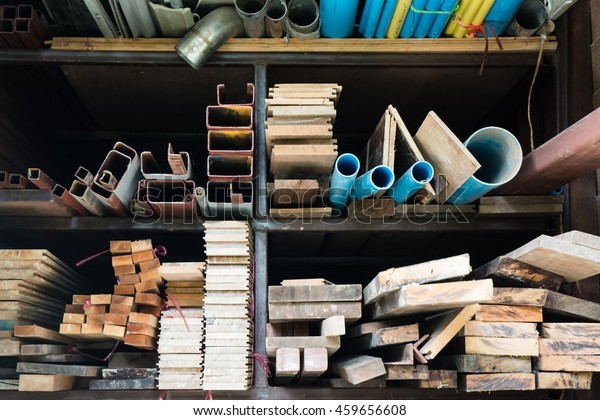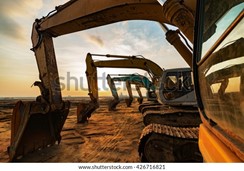Physical resources in building and construction refer to the plants, equipment, and machinery with which construction works are done with. There are several kinds and types of physical resources.
Excavators
A typical plant seen in construction sites is the excavator. The purpose of these is to excavate soil in a construction site to prepare other construction works. The most common excavator used in small to medium-sized excavations is the multi-purpose excavator. These excavators typically have excavating front buckets and a rear backacter bucket that can operate in a 180-degree arc. A hydraulic mechanism moves both buckets, of which the operator/driver has control.
Earthmoving equipment
Another common kind of plant seen in construction sites is earthmoving plants. The purpose of this kind of plant is to transport and place soil that the excavator has excavated. An example of an earthmoving plant is the bulldozer. These are track or wheel-mounted tractors with a forward-facing mould blade controlled by hydraulic rams. These are commonly used for stripping sites, reduced level digging, and pushing excavated soil from one point to another.
Hoists
Hoists are another type of physical resource that can be seen in a construction site. These are used to transport materials, and at times even passengers, vertically. Hoists are typically powered by diesel engines or electric motors that rotate a drum around which a wire rope, or sometimes chain, is wound.
The different types of hoisting equipment include the following:
i. Passenger hoists – these are designed to lift passengers. Typically, they are 2.7m high and can carry 12 passengers at a total of 1,000kg.
ii. Mobile hoists – these are commonly found in construction sites as they are designed to be easy to dismantle and moved to another location. Typically, they have a load capacity of 500kg and can lift material loads to a height of up to 30m.
Lifting equipment is used to transport materials from one point to another, which often happen in a construction site. An example of lifting equipment is the forklift. Forklifts are used to transport materials on pallets or packs horizontally or vertically. While they are mostly used in warehouses and industrial sites, they are also suitable for construction sites. They are typically used in the materials and goods storage process or for moving materials and goods to structures not exceeding a height of three storeys.
Mobile crane
Another machine used to transport materials and building elements from place to place in a construction site is the mobile crane. These are flexible cranes that can be moved within the site. The different types of mobile cranes differ by the way they are mounted and their lifting capacity:
i. Mobile-wheeled cranes – these are mounted on a wheeled chassis with stabilisers that help prevent movement when lifting. Their lifting capacity can range from 3 to 50 tonnes but is typically around 10 tonnes. Mobile-wheeled cranes are commonly used to move moderately heavy loads, equipment, and other plats in goods yards or storage areas.
ii. Truck-mounted cranes – these are mounted on trucks that have been specially modified to carry an increased load. Their lifting capacity can range from 5 to 2,000 tonnes, but the commonly used ones range from 35 to 100 tonnes. Truck-mounted cranes are very easy to transport and have short site preparation times, so they are typically used for short hire periods.
iii. Track-mounted cranes – these are mounted on diesel-powered crawler units with a lattice mask that a fly jib attachment can be added on to for additional lifting ropes that allow for better site coverage. Their lifting capacity can range from 5 to 30 tonnes. The tracks allow for this type of mobile crane to be operational on poor ground conditions.
Air compressors
Compressed air is often used in construction sites as a form of a clean power source. Air compressors used to produce compressed air are very mobile and easy to handle, which is beneficial for use in isolated sites or confined spaces. Equipment powered by compressed air is often used to break up rocks and pavements.
The two main types of air compressors are the following:
i. Reciprocating compressor – this type of compressor has a cylinder or series of cylinders where air passes through and compressed by either pistons or air at increasing pressures.
ii. Rotary compressor – this type of compressor has a high-speed rotor mounted in a cylinder. Air is drawn in by centrifugal force from an intake port and exits through the delivery port when the appropriate pressure has been met. As it exits the high-pressure cylinder, air receivers store the compressed air and eliminate pressure fluctuations.
Generators
A generator is used to power every other equipment that are not powered by compressed air. This machine converts mechanical energy into electrical power for electric-powered equipment where electricity is not readily available. The type of generator used in a construction site depends on the need of the project. Examples of generators used in a construction site are the following:
i. High-powered generators – these are used by construction sites that need to operate electrically powered heavy-duty machinery like earthmoving and material handling plants.
ii. Standby generators – these are kept in construction sites as a measure for temporary outages or power supply fails.
Pumps
Pumps are a type of equipment used to remove water from a volume of liquid. These are used for a number of different construction works, including lowering the water table below excavation level, pumping water out of cofferdams, and foundation grouting. Different types of pumps are used in different situations. Examples of pumps include the following:
i. Centrifugal pumps – this has a spinning impeller that produces a vortex that pulls air out of the hose. As a consequence of air pressure, water enters the pump.
ii. Air lift pumps – this has a long vertical pipe attached to a compressed air supply. The air carries the water to the discharge field from up the pipe.
In identifying what physical resources are required in a project, you must refer to the building site features, method of construction, and specified building materials.The physical resources required in a project will depend on these factors.
Example
For the construction of building ABC, John has previously identified that the ground condition will likely be poor, so the physical resources that will be required in the project will need to be track-mounted. As for what kind of physical resources the project needs, he has previously identified excavation as one of the required construction activities. Large building materials will also have to be transported around the site, and some parts of the site will have difficulty accessing electricity. Therefore, he identifies excavators, bulldozers, mobile cranes, and generators as physical resources required for the project.

In identifying what physical resource to hire from another organisation, one must consider the limitations of the physical resource to be leased. The limitations may include a physical resource's towing capacity, its mobility, its power output, and so on. The conditions of use of a physical resource must also be identified. The conditions of using a physical resource refer to the requirements that need to be met before the physical resource can be operated and used in a construction site.
An example of a condition of use of a physical resource is the high-risk work licence requirement. Certain plants require an operator who is above the age of 18 and has undergone a series of certifications that allows them to operate particular plants. Plants that require a high-risk work license include hoists, forklifts, and cranes. While the operation of a bulldozer, excavators, compressors, generators, and pumps are considered low-risk (therefore, do not need a licence to operate), a statement of attainment for operation training may be required by organisations to operate them in building and construction sites. A full list of plants that require a high-risk work license to operate can be found in Schedule 3 of the Model Work Health and Safety Regulations published by Safe Work Australia.
Operational costs are the costs incurred for the use of the physical resource. Operational costs may include maintenance costs, fuel costs for plants like bulldozers and mobile wheeled-cranes, and so on. Timeframes refer to the schedule of operation of the physical resource Timeframes are essential to determine, especially for plants, which the contractor for a project usually leases.
It is important to establish all of these as this information will be important in determining the cost of using the physical resource necessary for a construction project.
Example
For the construction of building ABC, John identifies the need for a mobile crane to move large building materials around the site. Specifically, the project calls for the use of a mobile track-mounted crane. For this physical resource, John determines the following:
|
Limitation
|
Condition of use
|
Operational cost
|
Timeframe
|
|
|
|
|
Now that you know the physical resources necessary for the construction project and their limitations, conditions, operational costs, and schedule for use, you can inquire about prices from the supplier.
Large plants and machinery will likely be hired instead of bought by your organisation for a construction project, which means suppliers will likely give you the cost to hire the specified plants and machinery per day of use. It is also important to discuss how the physical resources will be transported to the construction site with the supplier. Additional transportation costs may apply to large plants and machinery such as bulldozers, mobile cranes, and excavators.
Like in the previous section related to obtaining prices from suppliers, the procedure of doing so may vary between organisations. Typically, obtaining supplier prices may be as simple as sending the supplier a list of physical resources needed for a construction project. A schedule of usage for the physical resources is also sent with the list. Access and review your organisation's policies and procedures for obtaining prices from suppliers.
Example
John has identified the need for track-mounted excavators and bulldozers for the construction of building ABC. Following the organisational procedure, he contacts the organisation's suppliers to inquire about the price to hire these plants for the construction project. He also clarified the terms of transporting the plants from the supplier to the construction site. The supplier responded to John with the following quote:
|
Plant |
Cost to hire per day |
Cost to transport to/from construction site |
|
$120.60 |
$234.50 |
|
$131.70 |

You now have all the information necessary to properly itemise and cost the physical resources required for the construction project. In construction, plants refer to the heavy machinery and equipment used during construction activities. Equipment, on the other hand, refers to a set of tools used for a single purpose. Machinery refers to mechanised equipment used during construction activities that are not plants.
The procedure of itemising and costing physical resources may vary between organisations. Typically, itemising physical resources is done by listing down the plants, equipment, and machinery necessary for the construction project with the breakdown of their associated costs.





